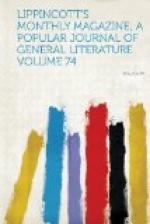Southall, a station or two beyond, suggests sport of a less lethal character, being an ancient meeting-place for the queen’s stag-hounds. John Leach may have collected here some of his studies of Cockney equestrianism. The sportsmen so dear to his pencil furnished him wealth of opportunities on their annual concourse at the cart’s tail. The unloading of the animal, his gathering himself up for a leisurely canter across country, the various styles and degrees of horsemanship among his lumbering followers, and the business-like replacing of the quarry in his vehicle, to be hauled away for another day’s sport, served as the most complete travesty imaginable of the chase. It has the compensation of placing a number of worthy men in the saddle at least once in the year and compelling them to do some rough riding. The English have always made it their boast that they are more at home on horseback than any other European nation, and they claim to have derived much military advantage from it. Lever’s novels would lose many of their best situations but for this national accomplishment and the astounding development it reaches in his hands.
[Illustration: MILTON’S Pear tree.]
To the left lies the fine park of Osterley, once the seat of the greatest of London’s merchant princes, Sir Thomas Gresham. An improvement proposed by Queen Bess, on a visit to Gresham in 1578, does not speak highly for her taste in design. She remarked that in her opinion the court in front of the house would look better split up by a wall. Her host dutifully acceded to the idea, and surprised Her Majesty next morning by pointing out the wall which he had erected during the night, sending to London for masons and material for the purpose. The conceit was a more ponderous one than that of Raleigh’s cloak—bricks and mortar versus velvet.
A greater than Gresham succeeded, after the death of his widow, to the occupancy of Osterley—Chief-justice Coke. His compliment to Elizabeth on the occasion of a similar visit to the same house took the more available and acceptable shape of ten or twelve hundred pounds sterling in jewelry. She had more than a woman’s weakness for finery, and Coke operated upon it very successfully. His gems outlasted Gresham’s wall, which has long since disappeared with the court it disfigured. In place of both stands a goodly Ionic portico, through which one may pass to a staircase that bears a representation by Rubens of the apotheosis of Mr. Motley’s hero, William the Silent. The gallery offers a collection of other old pictures. Should we, however, take time for even a short stop in this vicinity, it would probably be for the credit of saying that we walked over Hounslow Heath intact in purse and person. The gentlemen of the road live only in the classic pages of Ainsworth, Reynolds and, if we may include Sam Weller in such worshipful company, that bard of “the bold Tur_pin_.” Another class of highwaymen had long before them been also attracted by the fine manoeuvring facilities of the heath, beginning with the army of the Caesars and ending with that of James II. Jonathan Wild and his merry men were saints to Kirke and his lambs.




